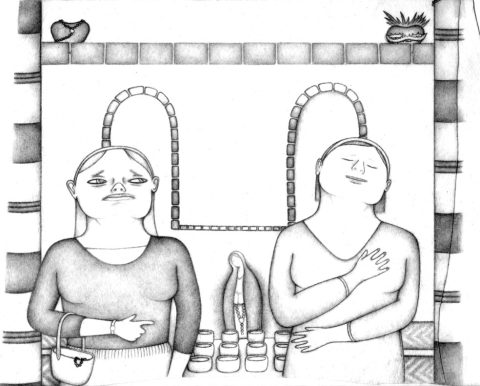They left the nunnery, where they’d been renting a room, already upset. On the day of their visit to the Sistine Chapel, the weather was hotter than expected and muggy. Emma was anxious to get to their destination. Charlotte complained about the new, stiff sandals she’d purchased at the market and the way her fine blonde hair went limp in the heat.
In her art history class, Emma had learned about Stendhal syndrome—named for the French author who’d entered a state of ecstasy while viewing frescoes at the Basilica di Santa Croce. Emma’s classmate—Charlotte’s boyfriend, Mark—scoffed at the idea of art as religious experience and said he found it offensive. Only God could inspire such feeling, he’d claimed. When Charlotte suggested the trip, Emma felt it was secret code: Charlotte wanted to believe.
The frescoes in Florence had left Emma wanting, but Charlotte stood in front of Michelangelo’s tomb, palm to her chest, and allowed herself to cry. Later, she’d pressed Emma over espresso. Did you feel it? Emma couldn’t admit to the fear charging through her body. It was quite a thing to see, she’d said and suggested they go to Rome, visit the Sistine Chapel, see the beach.
Now, Emma walked the small cobblestone streets to the Vatican, swerving in the heat, barely missing the edge of a car racing past, and let herself hope. The entrance to the Basilica was deeply shadowed, the outline wavering hotly. Outside, the line moved fast and then they entered the cool of the chapel.
Once inside, Charlotte adopted the manner of a girl raised in churches, reverent and fearful, her head held high as if a priest might round the corner and demand to know her relationship to God. Although Emma had gone to church here and there as a child, she’d never believed in a being orchestrating the universe. Emma observed a group of tourists following a guide who spoke directly into their ears through a headset microphone. Imagining the disembodied voice in her own ear, she wished for the comfort of hearing instead of finding her own answer.
After they bought tickets, they followed a crowd past gilded tapestries, ancient frescoes, and filigreed archways. Charlotte pushed forward, clearing the crowd like a rivulet while Emma followed, sluggish. They went down a slim stairwell without air vents. It was stifling, strangers pushing up against them, everyone sweating, the air unclean. As they inched forward, strangers avoided eye contact, everyone waiting to get closer to the entrance.
Then, there it was: the Sistine Chapel. Adam leaned an effortless arm toward God and was carried forward, relying on the exertion of angels to propel him forth. Emma thought of the day before—they’d gone to the beach. Later, she’d fallen asleep, bare skin smelling of sunblock and sunshine, and woke thick and sleepy to darkness. She’d reached for Charlotte and they’d moved together like the beads of a rosary and in the morning, Charlotte crumpled the blankets of the unused bed while Emma packed. At breakfast, the nuns came by with bread and butter, small pieces of fruit. Charlotte pretended it hadn’t happened.
Now, a babble of voices filled the chapel, louder than Emma expected. She was trapped between a group of elderly Australians snapping photographs and two large German men pressing her forward without concern. Her neck hurt. A flood of sound washed over her as the entering tourists began to talk. A guard shushed the crowd, and the sounds of voices diminished. A sick sweep of disappointment swelled in her stomach as she stared up at the ceiling. When she reached for Charlotte’s hand, they were moving again, pressed farther from each other as the crowd shuffled tightly forward.

Notes from Guest Reader Matt Sailor
I love the subtlety of the story, and the way the relationship between the two characters unfolds slowly. And I love the way art was used as a window to seeing deeper into the characters.


 The core workshop of SmokeLong Fitness is all in writing, so you can take part from anywhere at anytime. We are excited about creating a supportive, consistent and structured environment for flash writers to work on their craft in a community. We are thrilled and proud to say that our workshop participants have won, placed, or been listed in every major flash competition. Community works.
The core workshop of SmokeLong Fitness is all in writing, so you can take part from anywhere at anytime. We are excited about creating a supportive, consistent and structured environment for flash writers to work on their craft in a community. We are thrilled and proud to say that our workshop participants have won, placed, or been listed in every major flash competition. Community works.